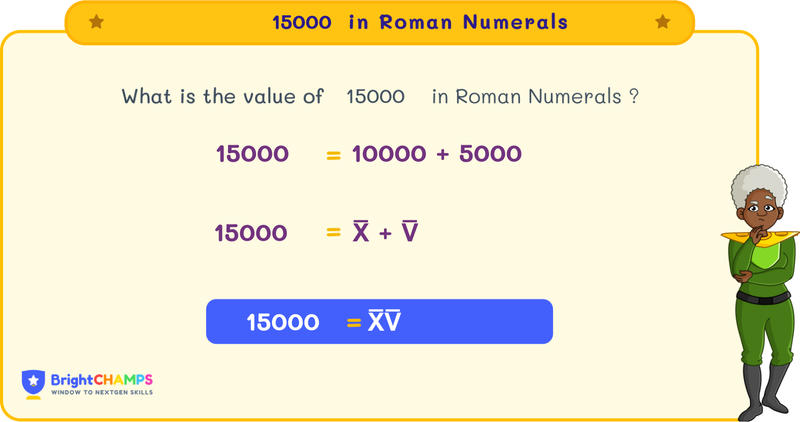Summarize this article:
 793 Learners
793 LearnersLast updated on August 5, 2025
15000 in Roman Numerals

Roman numerals are a way of expressing numbers using symbols. I, V, X, L, C, D, and M are the symbols we use. Roman Numerals are used in royal titles, book names, sequences, and so on. Here we will be discussing Roman Numerals, rules, and examples.

What is 15000 in Roman Numerals?
15,000 in Roman numeral is represented as X̅V̅. Here, X̅ represents 10,000 and V̅ represents 5,000. Thus, X̅V̅ = 10,000 + 5,000 = 15,000. Therefore, the value of 15,000 in Roman numerals is X̅V̅.
The above value is derived by combining the values of specific Roman numeral symbols used in the system.
Those are the Roman Numerals. Earlier people used to count using fingers, sticks, bones, etc. to count. When life became complex, a standard form was required to count. Ancient Romans used the Roman Numeral system to count. I (1), V (5), X (10), L (50), C (100), D (500), and M (1000) are the symbols we use to count.
In Roman Numerals, we use XV with a vinculum (a line over the numerals), to represent 15000, where X is 10000 and V is 5000. Let’s learn more about Roman numerals and how we write them.


Basic Rules for 15000 in Roman Numerals
There are certain basic rules to write a number in Roman Numerals. In this section, let’s discuss some basic rules that need to be remembered when writing a number in Roman numerals.
Rule 1: Addition Method
The addition method is used when the smaller number is placed after the larger number. For example, VI → V + I → 5 + 1 = 6
Rule 2: Repetition Method
To write a large number, there are certain Roman Numerals that can be repeated up to three times. III → 3.
Rule 3: Subtraction Method
If a small number is followed by a large number in Roman Numerals, we subtract the smaller number from the large number, it is a subtraction method. For example, IX → X - I → 10 - 1 = 9
Rule 4: Overline Rule
For numbers larger than 3999, a bar or vinculum is placed over a numeral to multiply its value by 1000. For example, \(\overline{X}\) is 10000.

How to Write 15000 in Roman Numerals
Let’s now learn how to write 15000 in Roman Numerals. Follow these methods to write the number in Roman Numerals.
- By Expansion Method
- By Grouping Method
Explore Our Programs



15000 in Roman Numeral by Expansion Method
In the expansion method, based on the place value, the number is broken down. In this section, we will learn how to write 15000 in Roman numerals using the expansion method. To write 15000 in Roman Numerals, follow the steps:
Step 1: Break the number based on the place value. Place values are ones, tens, hundreds, etc. For 15000, we write it as 10000 + 5000
Step 2: Converting the number into Roman Numerals 10000 in Roman Numerals — \(\overline{X}\) 5000 in Roman Numerals — \(\overline{V}\)
Step 3: Combining the Roman Numerals together. Therefore, 15000 in Roman Numerals is \(\overline{X}\) (10000) + \(\overline{V}\) (5000) = \(\overline{XV}\)

15000 in Roman Numerals by Grouping Method
When writing a large number into Roman Numerals, we group the number.
To write 15000 in Roman Numerals, we group 15000 as 10000 + 5000.
10000 in Roman Numerals — \(\overline{X}\)
5000 in Roman Numerals — \(\overline{V}\)
So, 15000 is written as \(\overline{XV}\) in Roman Numerals.

Common Mistakes and How to Avoid Them in 15000 Roman Numerals
Students make mistakes when writing a number in Roman Numerals. To master Roman Numerals, we can learn a few common mistakes and the ways to avoid them.

15000 in Roman Numerals Examples

Problem 1
A historian discovers a manuscript indicating a treasure was hidden in the year XV millennia ago from the current year. What year was the treasure hidden in?

The treasure was hidden in the year 13000 AD.
Explanation
XV millennia is 15000 years. If we subtract 15000 from the current year (assuming the current year is 2023), we get 2023 - 15000 = -12977.
This indicates the year 13000 BC, or 13000 years ago, the treasure was supposedly hidden.

Problem 2
A museum received a donation of XV paintings, each valued at M dollars. What is the total value of the donation?

The total value of the donation is XV million dollars.
Explanation
There are XV (15) paintings, and each is valued at M (1000) dollars. Therefore, the total value is 15 × 1000 = 15000.
In Roman numerals, 15000 is written as XV with a line over it, representing 15000.

Problem 3
A marathon was held to raise funds, and each participant pledged to run XV kilometers. If there were M participants, how many kilometers were pledged in total?

The total kilometers pledged were XV thousand kilometers.
Explanation
Each participant ran XV (15) kilometers, with M (1000) participants in total. Therefore, the total distance pledged is 15 × 1000 = 15000 kilometers.
In Roman numerals, this is written as XV with a line over it, representing 15000.

Problem 4
A researcher is studying ancient Roman architecture and finds a blueprint showing a building to be constructed with an area of XV square meters per floor. If the building has X floors, what is the total area?

The total area is CL square meters.
Explanation
Each floor has an area of XV (15) square meters, and there are X (10) floors.
Therefore, the total area is 15 × 10 = 150 square meters.
In Roman numerals, 150 is written as CL.

Problem 5
A charity distributes XV thousand meals each month. If they continue at this rate, how many meals will they distribute in a year?

They will distribute CLXXX thousand meals in a year.
Explanation
Each month, XV (15) thousand meals are distributed.
In a year (12 months), the total distribution is 15 × 12 = 180 thousand meals.
In Roman numerals, 180 is CLXXX, so the total is CLXXX thousand meals.


FAQs on 15000 in Roman Numerals
1.What is the Roman numeral representation of 15000?
2.How to write 15000 in Roman numerals?
3.What is 16000 in Roman Numerals?
4.Is XV a prime number?
5.What are the multiples of 15000?
6.What’s the Roman numeral breakdown of 15,000?
7.What comes before and after XV̅ in Roman numerals?
8.Can Roman numerals like X̅V̅ be used in modern times?
9.How do you pronounce XV?
10.What is the rule for writing 15000 in Roman numerals?

Important Glossaries for 15000 in Roman Numerals
- Addition rule: The addition method is used when a large number is followed by a smaller numeral, here the values are added. For example, VI = V + I = 5 + 1 = 6.
- Grouping method: Here the given numbers are grouped based on their place value and then we convert each group into its Roman numerals. For example, 15000 = 10000 + 5000 = \(\overline{XV}\).
- Repetition rule: Certain symbols (I, X, C, M) in the Roman numeral system can be repeated only up to three times. For example, III = 3 (I is repeated three times to represent the number 3).
- Overline rule: An overline placed over a numeral multiplies its value by 1000. For example, \(\overline{X}\) = 10000.
- Subtraction rule: The subtraction method is used when a smaller numeral precedes a larger numeral, indicating subtraction. For example, IV = 5 - 1 = 4.



Hiralee Lalitkumar Makwana
About the Author
Hiralee Lalitkumar Makwana has almost two years of teaching experience. She is a number ninja as she loves numbers. Her interest in numbers can be seen in the way she cracks math puzzles and hidden patterns.
Fun Fact
: She loves to read number jokes and games.

















